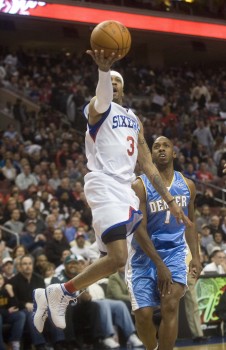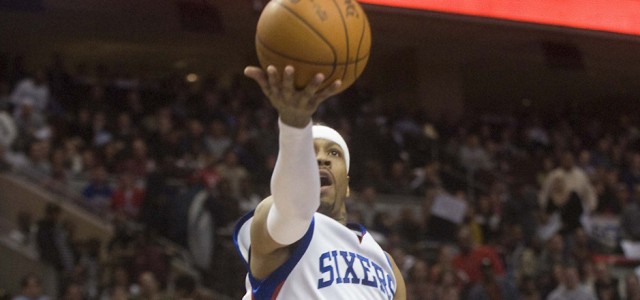WHEN I WAS 18 and trying to win a college scholarship, I used to work out with a trainer named John Hartnett. One day he took me into a gym and I was surprised to find NBA players there. All of them seemed bigger than life, but the one who stood out to me was Allen Iverson.

Allen Iverson drives past Denver’s Chauncey Billups in the second quarter of a December 7, 2009 NBA basketball game at Philadelphia.
I thought of that day in the gym when I witnessed Iverson’s retirement ceremony the other night. I thought of that day and recalled the things I learned while running the court with Iverson all those years ago.
He was a small point guard with just a few tattoos at the time, cornrows resembling crop patterns on a Southern plantation, and a vicious attitude that would accept nothing less than winning. See, Allen Iverson played basketball. And when he played, it was more than a game.
That day in the gym, I learned that Iverson was the fastest player I would ever share a court with. He was quicker than anybody, playing with the kind of hunger only struggle can teach. His arms reached past his knees with huge hands that were made to hold the game itself in his palms. Allen’s legs were coils that bounced his 5-foot-11, 160-pound frame into the air on his command. Whether it was one or two handed dunks, or that signature crossover with a Hip-Hop wingspan, he rarely disappointed, and electrified anyone who watched him play on his “dance floor.”
Iverson’s imprint will forever be engrained, not only in my memories of that day, not only in the essence of the NBA, but also in the very fabric of our culture.
He was more than a gifted basketball player that shifted the culture of the league. He was—no, is—a global icon. Through transparent authenticity he became a walking rebellion that often pushed boundaries, challenging the freedom of body language with his numerous tattoos, the freedom of speech with the things he said, and the freedom to be who you are with the things he did. His impact was so strong little white kids were wearing cornrows, which were at one point considered a “thug’s look.”
In 2000, Hoops magazine placed Iverson on the cover with his jewelry and tattoos airbrushed. Iverson was infuriated and called for a retraction. But maybe that’s just how the NBA truly felt about his impact and the culture he brought into the sport. It didn’t matter. His influence was too enormous for the NBA to control. He proved you can’t box in freedom. A freedom even some Black people were uncomfortable with.
“He was more than a gifted basketball player that shifted the culture of the league. He was—no, is—a global icon. Through transparent authenticity he became a walking rebellion that often pushed boundaries, challenging the freedom of body language with his numerous tattoos, the freedom of speech with the things he said, and the freedom to be who you are with the things he did. His impact was so strong little white kids were wearing cornrows…”
He didn’t just dance on the court, but he danced on the connective line that draws blackness and Hip-Hop close together. If Allen Iverson were a clean skinned basketball player with unbraided hair, a man who barely made mistakes, then the love affair with him wouldn’t be as strong. He would be more like Dwayne Wade, and that’s not who we wanted.America loves the edgy, risk-taking entertainer who smacks authority in the face by throwing caution to the wind. Part of the infatuation with Iverson was his ability to fight through pain. With over 20 injuries throughout his career he indirectly helped celebrate hyper masculinity. He even stated, “You can’t be soft and play this game.” I don’t know if that’s a good or bad thing, but one thing is sure. People love resilience and he represented it to the fullest. Iverson spoke to our deepest desires and mirrored our needs for genuine liberty to be who we really wanted to be, especially those of the Hip-Hop generation. The NBA created the dress code or many would say “The Iverson Rule,” because of him.
When all is said and done the man left it all on the court and that’s what people loved. He represents how many feel everyday when they go to work or school, and that’s commanding the space of your personal existence to be who you want to be without worry, so you can practice true freedom. But is he really free? Can he live without basketball? Will people still want to take pics with the icon that he is years later? Will he be as important 10 years from now? Only time will tell. But remember when you see those tattoos and braids on the court it came from a 5-foot-11 spark of life named Allen Iverson. The greatest little man to ever play the sport of basketball.
 Greg Corbin is a poet, teacher, and regular contributor to Solomonjones.com
Greg Corbin is a poet, teacher, and regular contributor to Solomonjones.com








